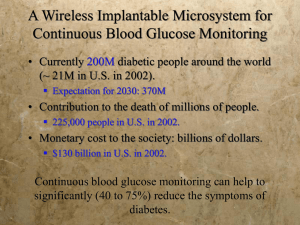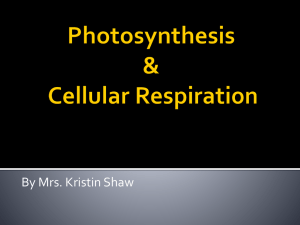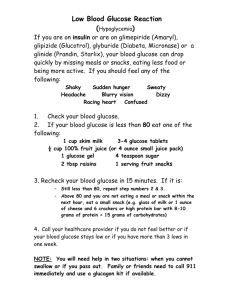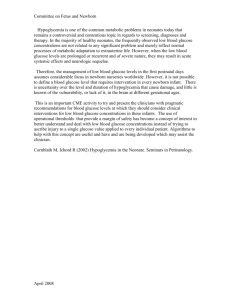Biosensors – Part two - Linköping University
advertisement
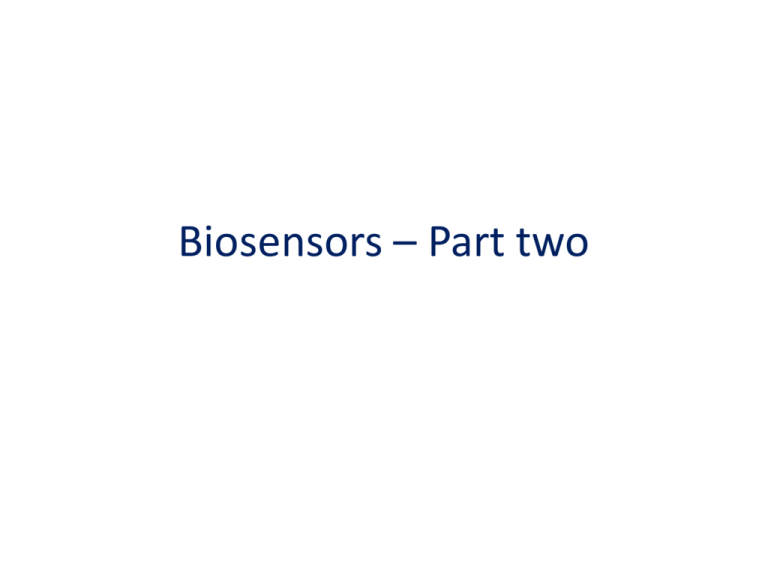
Biosensors – Part two “Second part” : Two successful technologies • Electrochemically based glucose monitors • Biospecific interaction analysis with SPR “Forgotten items” • • • • • • • Microcantilevers Molecular imprints Nanoparticles (Au, silica,..) Nanotubes Graphene Ion sensitive field effect devices ----------------- Glucose Sensors for Diabetes Material provided by prof. Anthony Turner Biosensors and Bioelectronics Centre Department of Physics, Chemistry and Biology Linköping University The Diabetes Health Care Space $0.35B $5.6B $5.2B $12.1B IMS and EAC data - 2004 Insulin Oral Anti-Diabetics Blood Glucose Monitoring Lancets and other paraphernalia Source: Frost & Sullivan A brief chronology of home testing for glucose Urine testing using, for example, Clinitest Reagent Tablets (1941) followed by visually read paper test strips for urine (1956) Visually read paper strip for blood glucose (1964) Instrument to measure paper strip by reflectance of light (1969) First electrochemical home blood glucose monitor (1987) First devices to fill by capillary action: Medisense QID (1995); Bayer / KDK / Menarini (1996) Yellow Springs Instrument Company Inc (YSI) The original YSI serum-glucose biosensor for diabetes clinics 1975 Glucose Biosensor 1975 Clark, LC & Lyons, C (1962). Annals New York Ohio 1987 Academy ofYSI, Sciences 102, 29. 1987 The YSI Analyser 1500 Sport Analysers 7 A conventional enzyme electrode Enzyme Electrode Reactions 9 Mediated Enzyme Electrode Glucose oxidase or PQQ Glucose Dehydrogenase Cass, A.E.G., Davis, G., Francis, G.D., Hill, H.A.O., Aston, W.J., Higgins, I.J., Plotkin, E.V., Scott, L.D.L. and Turner, A.P.F. (1984) Ferrocene-mediated enzyme electrode for amperometric determination of glucose. Analytical Chemistry 56, 667-671. 10 Key bioelectrochemical reactions GOx D-glucose + H2O + O2 H2O2 Anode D-glucose + 2 Medox+ (NH2)2CO + 2H2O + 2H+ + O2 + 2e- GOx Urease + H C2H5OH + NAD+ NADH Anode gluconic acid + H2O2 gluconic acid + 2 Medred HCO3- + 2NH4+ ADH 2NH3 + 2H+ C2H5O + NADH NAD+ + 2e- + H+ Glucose response (mediated amperometric electrodes) “Too little enzyme”or “Mediators” Clinically Important Enzyme Electrodes Electrode Enzymes Amperometric Oxygen electrode, hydrogen peroxide detection at platinum or carbon electrodes or mediated amperometry Oxidases e.g. Glucose oxidase (GOx), Lactate oxidase, Galactose oxidase, Pyruvate oxidase, LAmino Acid oxidase, Alcohol oxidase. Oxalate oxidase, Cholesterol oxidase, Xanthine oxidase, Uricase. Platinum, carbon, chemically-modified, mediated amperometric electrodes Dehydrogenases e.g. Alcohol dehydrogenase, Glucose dehydrogenase (NAD and PQQ), Lactate dehydrogenase Potentiometric Ammonia Gas-Sensing Potentiometric Electrode, Iridium Metal Oxide semiconductor probe Creatinase, Adenosine deaminase pH Electrode, Filed-effect Transistor (FET) Penicillinase, Urease, Acetylcholinesterase, GOx Carbon Dioxide Gas Sensor Uricase, inhibition of dihydrofolate reductase, salicylate hydroxylase Mediated Amperometric Glucose Sensors MediSense ExacTech™ 1987: Ferocene Johnson & Johnson Lifescan FastTake™ 1998: Hexacyanoferrate 14 Mass Production: Screen Printing Current Paradigm of Blood Glucose Monitoring Dispose of materials Read test strip Deposit blood drop on to test strip & insert strip Prick finger or arm Load lancet into launcher and reassemble launcher 1-2 Minutes Burdensome and lengthy process is impediment to high compliance Integ LifeGuide – Minimally Invasive • Acquired by Inverness Medical Oct 2000 • Draws a tiny sample of interstial fluid (about 1 μl) from the outermost layers of the skin on the forearm in 8-10 secs • The unit then analyzes it for glucose in 30 secs • “Key” (white section) is disposable • Process avoids capillaries and nerve endings therefore is bloodless and eliminates pain associated with lancing a finger 17 The Future for Integration Metrika HbA1c: Microelectronics, optics & dry reagent chemistry inside a self-contained, integrated, Wen Qiao (University of single-use device. California) microfluidic chip powered with a commercially available radio frequency transmitter for electrophoresis Printed RFID trechnology Skin RFID tattoo The Arrival of Continuous Glucose Monitoring (CGM) Medtronic Guardian Dexcom STS Abbott Freestyle Navigator Meter Kit Sensors/m FDA approval $1,339 $350 (10x3day) Aug 2005 $800 $240 (4x7day) March 2006 $960-1,040 $360-390 (6x5 day) March 2008 (CE June 07) Reading Frequency 1 per 5min (2h run in) 1 per 5min (2h) 1 per min (10h run in) Reading must be checked by finger-stick method before adjusting insulin Minimally-Invasive and Non-Invasive Systems Pendragon Pendra Pendra was CE approved in May 2003 and was available on the Dutch direct-to-consumer market. A post-marketing reliability study was performed in six type 1 diabetes patients. Mean absolute difference between Pendra glucose values and values obtained through self-monitoring of blood glucose was 52% and a Clarke error grid showed 4.3% of the Pendra readings in the potentially dangerous zone E. Pendragon now bankrupt. Cygnus Glucowatch Biographer Cygnus Inc. in Redwood City, California, has gone out of business and has stopped manufacturing its meters. It sold essentially all of its assets to Animas Corp. (which makes insulin pumps) for $10 million. Futrex Inc 1992: Non-invasive glucose monitoring using NIR The U.S. Securities and Exchange Commission charged Futrex with fraud, claiming that the Dream Beam never worked. 21 Non-invasive Monitoring A selection of the apparently most active from >95 companies identified. Bold = in clinical trials Glucotrack: ultrasound + thermal and electromagnetic conductivity GlucoLight HypoMon: 4 electrodes; electrophys changes Cnoga “The science fiction you were speaking about is reality “ COMPANY TECHNOLOGY SITE BioTex Inc, TX, USA Near-infrared Skin Sensys Medical (Sensys GTS), AZ, USA Near-infrared Skin Cascade Metrix Inc, IN, USA Mid-infrared/microfluid Skin Light Touch Medical Inc, PA, USA Raman spectroscopy Finger Integrity applications (GlucoTrack), Israel Photoacoustic spectroscopy Ear lobe VeraLight Inc (Scout DS), NM, USA Fluorescence spectroscopy Skin Lein applied diagnostics, UK Optical Eye Glucolight Corp (Sentris -100), PA, USA Optical coherence tomography Skin Echo Therapeutics (Symphony tCGS, MA, USA Sonophoresis Skin Calisto Medical (Glucoband), TX, USA Bio-Electromagnetic Resonance Wrist AiMedics (HypoMon), Australia Electro-physiological Chest skin Biosign technologies (UFIT TEN-20), Canada Electro-physiological Wrist Cnoga Inc. (SoftTouch), Israel Optical (cell colour distribution) Skin EyeSense, Germany Bio-chemical/fluorescence Eye (ISF) VivoMedical, CA, USA Sweat analysis Skin The Evolution of Home Blood Glucose Monitoring Past The original Miles Glucometer Evolution of Blood Glucose Monitor products Present MediSense Mediated sensor CGM Medtronic Guardian Non-invasive monitoring (research) Future Supramolecular Devices? Newman, J.D. and Turner, A.P.F. (2008) Historical perspective of biosensor and biochip development. In: Handbook of Biosensors and Biochips (Eds R. Marks, D. Cullen, I. Karube, C. Lowe and H. Weetall) John Wiley & Sons. ISBN 978-0-470-01905-4 Conclusions Conclusions • Mediated amperometric glucose biosensors continue to dominate the home diabetes diagnostics market • Peroxide based amperometric glucose biosensors predominate in the decentralised and in vivo markets • The sector is typified by companies seeking to acquire a full set of technologies and pursuing high levels of integration (multi-sensors + multi-lancing &/or insulin injection) and sophisticated data treatment, displays and transmission • Implantable sensors are in the market and home-use automated systems coupled to insulin infusion have been announced • Non-invasive techniques have obvious attractions, but are meeting serious (insurmountable?) technical hurdles BIOSENSING WITH SURFACE PLASMON RESONANCE ”Real – time biospecific interaction analysis without labels” Based partly on material from Dr. Stefan Löfås, GE Healthcare, Uppsala Biosensors and Bioelectronics Centre Surface Plasmon Resonance (SPR) principle Increasing n Metal: Au ~50 nm Wavelength λ ~700 nm Light intensity decay length ~100 nm k = 2π/λ The Prelude: 25 years of SPR Angular scanning IgG a-IgG Ag Dsp Liedberg, Nylander and Lundström. Sensors & Actuators, 1983, 4, 299-304, Liedberg, B., Nylander C. & Lundstr6m, I. (1983). Surface plasmon resonance for gas detection and biosensing. Sensors and Actuators 4, 299-304 CM-Dextran Modified Surface, e.g. Sensor Chip CM5 Carboxylated Dextran Gold film Glass substrate 50 nm • • • • • • • Hydrophilic Non-crosslinked Flexible Extends from the surface Low non-specific binding High binding capacity Easy to activate and use for covalent coupling Covalent coupling chemistries O Ligand O PDEA COOH EDC/ NHS NH2 Amine SS Ligand Ligand thiol SS Ligand Surface thiol O C N H O C NH Ligand S Ligand S SH N C N H C O N 1) Cystamine 2) DTE (DTT) Hydrazine O C N H Ligand SS N O C N H 1) Ligand C O C SH O H NHNH2 2) NaBH3CN O C NHNHCH2 Ligand Aldehyde Carboxyl group for covalent attachment of molecules to the sensor surface Dextran matrix Gold Glass support Pneumatic valve Determination of the position of the reflectance minimum replaced by the movement of a dark band on a diode array or (CCD) camera Biomolecular interactions DNA hybridization Early example of BIA The Biology Project The University of Arizona Identification of the subclass of an unknown monoclonal ab Principles of biosensing with an extended coupling matrix and surface plasmon resonance, Sensors and Actuators 8, 11 (1993) 63- 72 B. Liedberg and I. Lundström Laboratory of Applied Physics, Linköping University, S-581 83 Linköping (Sweden), E. Stenberg, Pharmacia Biosensor AB, S-751 82 Uppsala (Sweden) Some numbers • SAM layer ~ 2 ng/mm2 • Dextran layer ~2-3 ng/mm2 • Surface chemistry modification and immobilization reproducibility: typically CV< 5 % • 1000 RU corresponds to ∆Θsp ≈ 0.1₀ • Sensitivity limits (Biacore A100) • 1 RU ~1 pg/mm2 • Detection spot in Biacore A100 = 0.01 mm2 => 10 fg/spot • Protein (100 kDa) binding => 0.01 attomole/spot • Drug molecule (500 Da) binding => 2 attomole/spot • • • • • Antigen – antibody DNA hybridization Drug – receptor Pollutant – ligand (protein, aptamer, DNA • • • • • Antibody selection Drug discovery; drug testing Environmental monitoring Food quality Cornerstones of Biacore™ systems Surface Plasmon Resonance (SPR) detection system User-friendly software Sensor chip Microfluidic system The Early Story of SPR for Biosensing • • • • • • 1983 Liedberg, Nylander, Lundström, Surface Plasmon Resonance for gas detection and biosensing, Sensors and Actuators 4(1983) 299-304 1984 Research program initiated within Pharmacia AB and Pharmacia Biosensor established 1986 Fundamental principles verified in prototype 1988 Research phase concluded, product development phase started 1989 Marketing organization established 1990 Launch in October and first sale of instrument Business aspects of the Biacore development • • • • • • • 1990-1993 Market introduction; survival or closed shop? 1994-1997 Market acceptance; company stabilization 1996 Pharmacia Biosensor becomes Biacore AB 1998-2002 Rapid organic expansion, brand established 2003-2004 Regression … 2005 Turn around and new growth strategy, revenues back on track (~ 85 million USD) 2006 Biacore acquired by GE Healthcare for ~450 million USD Unique Biological Information Specificity Kinetics & Affinity Concentration Thermodynamics How specific is the interaction? How fast and how strong is the interaction? How much biologically active protein is present? What drives the interaction? Data generated gives critical insights into protein functionality, the role of proteins in normal and diseased states, and the influence of potential drug candidates Kinetic properties have therapeutic consequences – Kinetic properties affect multiple aspects of drug function (e.g. pharmacokinetics, dosing) Rapid kinetics: frequent administration of low dose required to occupy target 100 % blocked target Slower kinetics: administration of high dose occupies target for long time 0 0 2 4 6 8 hours This information is critical to therapeutic performance of drugs since duration of efficacy depends on the receptor-drug complex association and dissociation rate constants Use of label free kinetics for antibody analysis Life science research Antibody development RU 14 Step 1 12 10 8 Response 13°C 6 4 2 0 wt mutant 45°C -2 -100 0 100 200 300 400 500 600 700 800 900 s Time RU Step 2 16 11 Response 0 6 • improved affinities 1 -4 -100 100 200 300 400 500 600 700 800 900 s Time 20 15 Step 3 Response Biological relevance Structure –function Interactomics 0 RU 10 5 0 -5 -100 0 100 200 300 400 Time 500 600 700 800 900 s • similar affinities • slower off rates Screen Select Characterize Improve Industrial process Antigen and Fc Receptor binding Possibilities • Imaging (S)PR (multispot arrays) • Plasmonics in nanostructures/-particles • Combination of the two • SPR and mass spectrometry • SPR and QCM - D • SPR and microcalorimetry An Optofluidic Nanoplasmonic Biosensor for Direct Detection of Live Viruses from Biological Media Yanik et. al., Nano Lett. 10 (2010) 4962 – 4969 Nanostructured digital microfluidics for enhanced surface plasmon resonance imaging, Malic, Veres, Tabrizian, Biosensors & Bioelectronics 26 (2011) 2053 - 2059 Conclusions • Biosensors have achieved considerable success in both the commercial and academic arenas and the need for new, easy-to-use, home and decentralised diagnostics is greater than ever • Amperometric biosensors continue to dominate the market • Electrochemical biosensors are available for a range of decentralised analyses, including medical, food and environmental applications • Array-based fluorescence sensors are now well established for genomic and proteomic assays • Label-free assays based on SPR dominate the laboratory affinity sensor market especially in drug development • The search continues for a new disruptive technology! Electrochemistry in Diabetes Management Adam Heller ACCOUNTS OF CHEMICAL RESEARCH, Vol. 43, No. 7 July 2010 963-973 Direct optical detection in bioanalysis: an update Günter Gauglitz Anal Bioanal Chem (2010) 398:2363–2372 A survey of the 2006–2009 quartz crystal microbalance biosensor literature Bernd Becker and Matthew A. Cooper J. Mol. Recognit. 2011; 24: 754–787 Lab-on-a-chip based immunosensor principles and technologies for the detection of cardiac biomarkers: a review Mazher-Iqbal Mohammed* and Marc P. Y. Desmulliez Lab Chip, 2011, 11, 569–595
